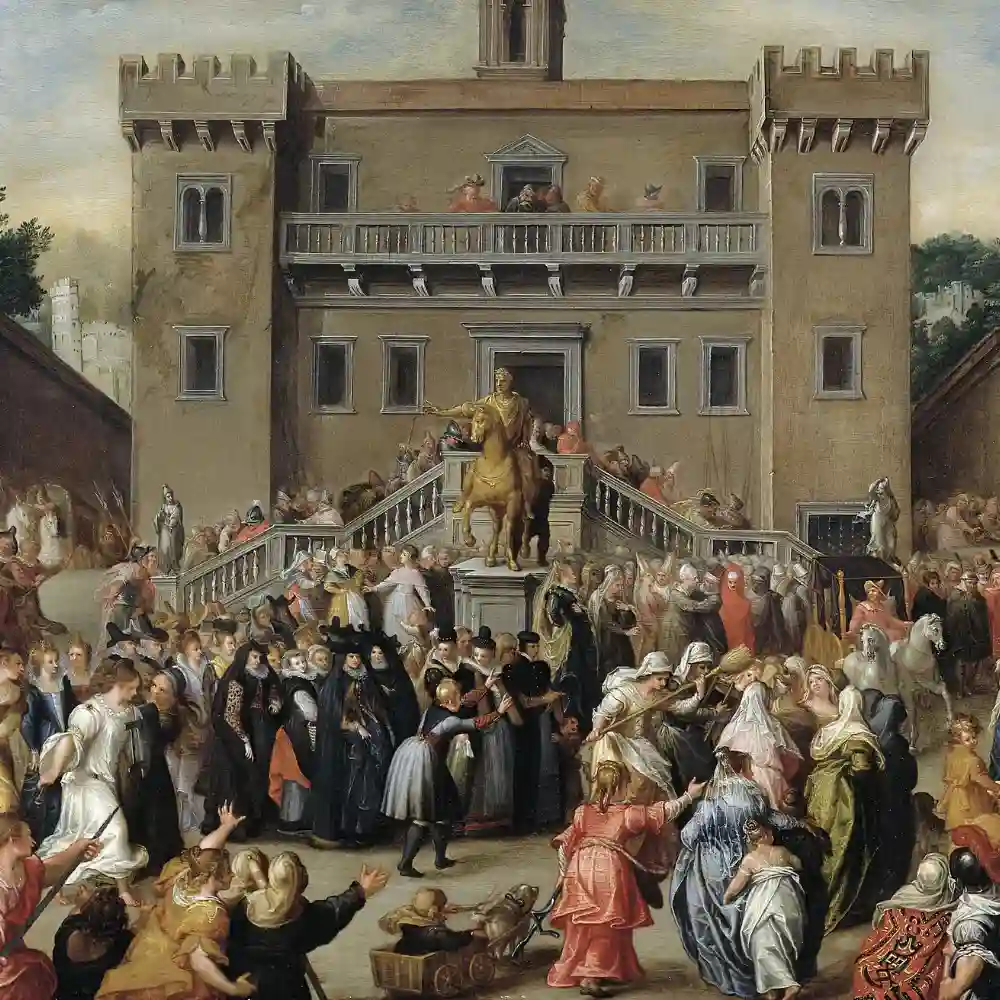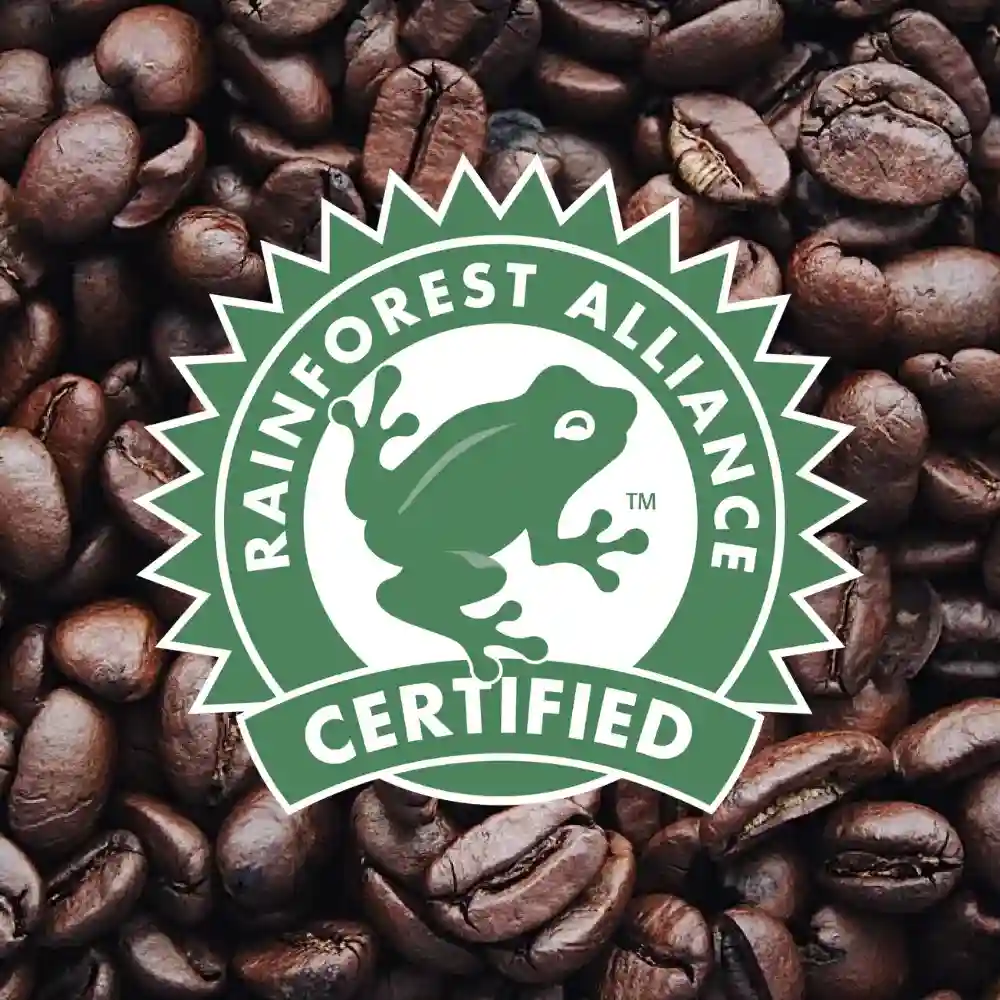In the pantheon of warm, comforting beverages, two reign supreme: hot chocolate and coffee. These beloved drinks, steeped in rich history and unique cultures, have become staples in our daily rituals, social gatherings, and quiet moments of reprieve. But have you ever wondered how these two iconic beverages stack up against each other in an all-out face-off? Welcome to our in-depth exploration of hot chocolate vs. coffee.
Whether you’re reaching for a cup of joe to kickstart your morning or winding down with a soothing mug of hot cocoa, each drink carries a distinct charm and a host of benefits. Hot chocolate, often associated with sweet indulgence, soothes our souls with its creamy richness and nostalgic allure. On the other hand, coffee, with its complex flavors and energizing properties, has become a lifeline for many, a vehicle of productivity, and an art form in its own right.
As we delve into this fascinating journey comparing hot chocolate and coffee, we’ll not only explore their origins and the cultures they’ve influenced but also their health benefits, role in modern lifestyle, and the science behind our love for these beverages. It’s not just about choosing sides in the hot chocolate vs. coffee debate; it’s about understanding and appreciating the deep complexities and enduring appeal of these two iconic drinks. So, grab your favorite mug and settle in; we’re just getting started.
Hot Chocolate vs. Coffee: Key Takeaway
- History in Every Sip: Both coffee and hot chocolate boast rich histories that span centuries, intertwining with various cultures, civilizations, and trade routes across the world.
- Taste the Diversity: The diversity of flavors in both coffee and hot chocolate mirrors the variety of cultures and regions they represent, offering a global exploration with every cup.
- More than a Beverage: Coffee and hot chocolate go beyond being mere drinks; they’re integral parts of our social fabric, representing comfort, community, ritual, and even creativity.
- A Healthy Balance: Both coffee and hot chocolate come with a host of health benefits when consumed in moderation, ranging from cognitive enhancements to cardiovascular health.
- Unraveling the Science: Understanding the psychological and neurological responses behind our love for coffee and hot chocolate adds a new dimension to our appreciation of these beloved beverages.
Understanding the Flavor Profiles
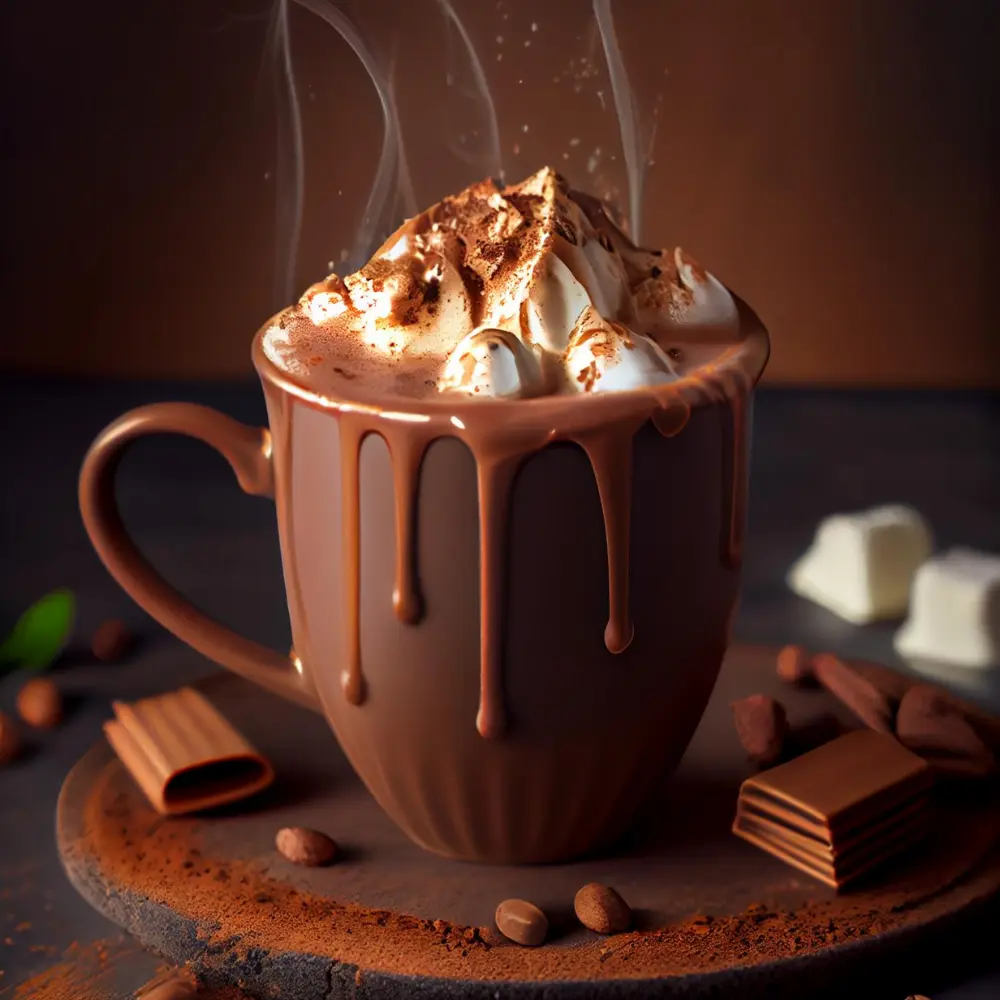
The flavors of hot chocolate and coffee are as diverse and unique as their histories. Both beverages are celebrated worldwide, not just for their comforting warmth, but also for their distinctive taste profiles. From the robust and varied palate of coffee to the decadent sweetness of hot chocolate, each drink brings a unique experience to our taste buds.
Coffee: A Symphony of Richness and Complexity

Coffee is not just a drink; it’s an experience, a sensory journey that engages not only taste but also smell. The aroma of coffee, often described as one of the most pleasant scents, plays a significant role in its overall flavor profile.
- Coffee beans’ flavor is influenced by many factors, including the variety of the plant, the altitude and climate where it’s grown, and the methods of harvesting and processing.
- Depending on these factors, coffee can display a broad spectrum of flavors, from sweet and fruity to bitter and earthy.
- Coffee is often described as having notes of chocolate, caramel, nuts, berries, or even floral undertones. The flavor is also impacted by how it’s brewed – an espresso will have a different flavor profile than a French press or a pour-over.
- The complexity and richness of coffee make it not just a beverage, but a hobby for many. Coffee tasting, similar to wine tasting, is a pursuit for those who love to explore the multitude of flavors this beloved drink can offer.
Hot Chocolate: A Sweet Treat Across the Globe
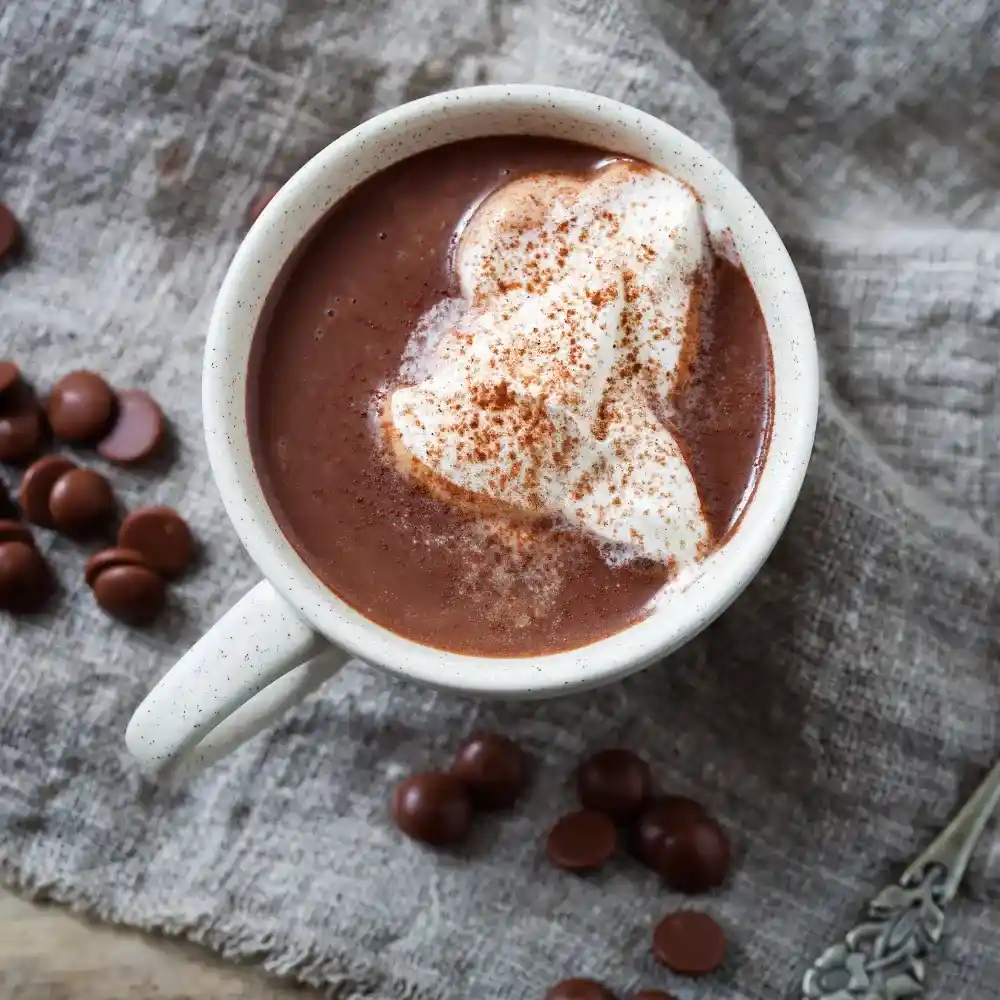
On the other side of the hot chocolate vs. coffee debate is the indulgent, creamy sweetness of hot chocolate. Unlike coffee, hot chocolate is typically associated with sweetness and decadence, but its flavor profile can be just as complex and varied.
- The primary ingredient, chocolate, can vary dramatically in flavor depending on the type of cocoa beans used, where they are grown, and how they are processed and prepared.
- Classic hot chocolate is a blend of milk, sugar, and cocoa, resulting in a smooth, sweet, and creamy drink. However, variations around the world add unique twists. For example, Mexican hot chocolate often includes spices like cinnamon and chili, giving it a warm, spicy kick.
- Some regions use dark chocolate for a less sweet and more cocoa-forward flavor, while others may add additional flavorings such as vanilla, nutmeg, or even peppermint.
- The overall experience of drinking hot chocolate also plays a role in its appeal. The creaminess, warmth, and sweet flavors often evoke feelings of comfort and nostalgia.
Finding Your Sweet Spot: When to Choose Each Drink

Choosing between hot chocolate and coffee often depends on personal preference and context.
- If you’re seeking a morning pick-me-up or an afternoon boost, the caffeinated jolt of a coffee might be your go-to. The versatility of coffee also allows for customization to suit your mood – be it a strong, black coffee for a serious caffeine hit or a latte for a more mellow and milky option.
- On the other hand, hot chocolate might be the perfect choice for a cozy evening in, a comforting treat on a cold day, or whenever you’re in the mood for something sweet and soothing.
- That said, exploring the diverse flavor profiles of both hot chocolate and coffee can reveal new favorites and experiences. There’s a world of flavor to discover in each cup.
Whether you’re a coffee connoisseur, a hot chocolate devotee, or someone who enjoys both, appreciating the depth of flavors in these popular beverages enhances the experience and adds to the ongoing hot chocolate vs. coffee discussion.
The Art of Pairing: Foods That Compliment Coffee and Hot Chocolate
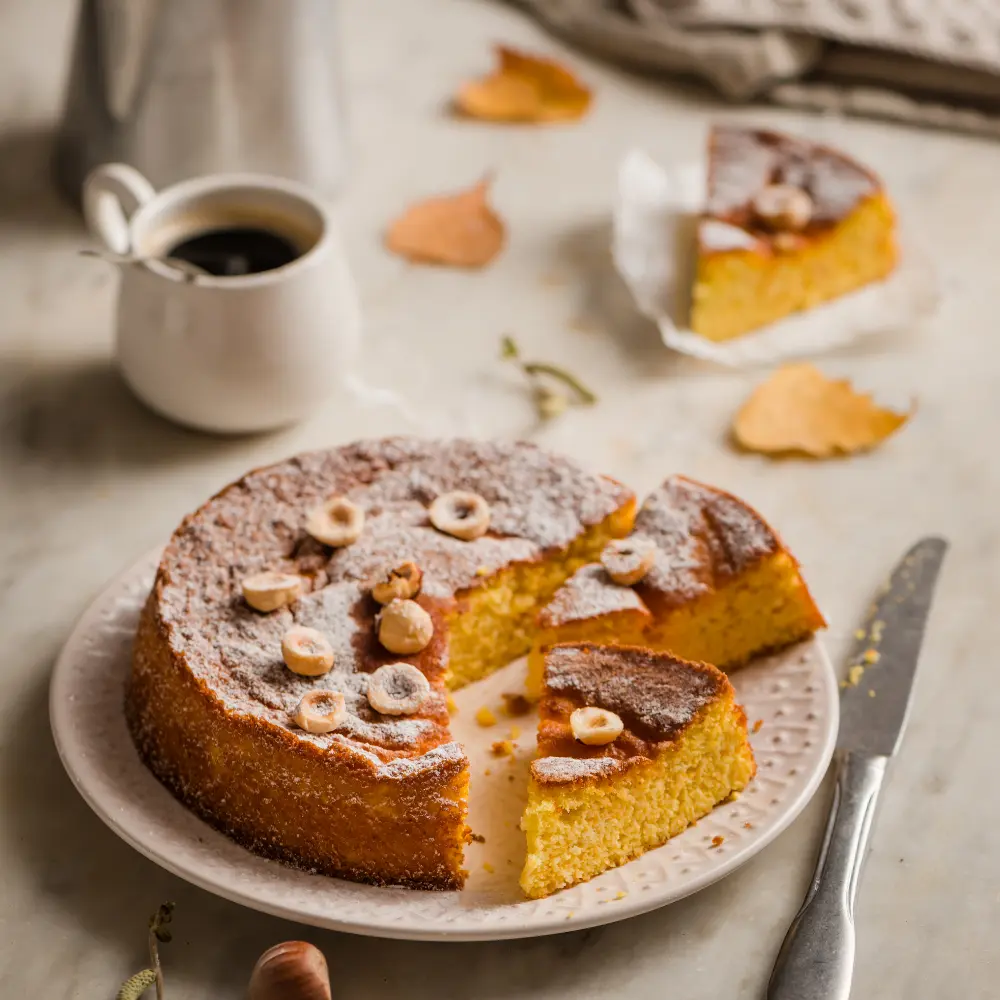
Just like wine, coffee, and hot chocolate can be paired with certain foods to enhance and complement their flavors. Whether you’re savoring a coffee with breakfast or treating yourself to a mug of hot chocolate after dinner, these pairings can elevate your enjoyment of these beverages.
When it comes to coffee pairing, the choice of food can depend on the coffee’s flavor profile
- For a light roast with fruity and acidic notes, try pairing it with breakfast foods like croissants or fruit tarts. The lightness of the pastry and the sweetness of the fruit can balance the coffee’s acidity and enhance its fruity flavors.
- Medium roast coffee, often characterized by its balanced flavor, pairs well with slightly richer foods like milk chocolate or creamy desserts. The creaminess of these foods can complement the coffee’s body and bring out its sweetness.
- Dark roast coffee, known for its bold and robust flavor, pairs well with strong, rich foods. Think dark chocolate, spicy dishes, or even grilled meats. The strong flavors in these foods can stand up to the robustness of the coffee.
Pairing Foods with Hot Chocolate
Hot chocolate, with its creamy and sweet profile, also has its own delightful pairings.
- Classic hot chocolate pairs wonderfully with plain cookies or shortbread. The simplicity of these treats allows the chocolate’s flavor to shine, while the buttery cookies complement its richness.
- For a spicier hot chocolate, consider pairing it with churros or cinnamon rolls. The spiciness in the chocolate can be enhanced by the cinnamon in these desserts, creating a harmonious blend of flavors.
- If you’re enjoying a dark hot chocolate, try pairing it with berries or a tart fruit. The fruit’s acidity can cut through the chocolate’s richness and bring a pleasant contrast of flavors.
Whether you’re diving into the art of coffee pairing or exploring what goes best with hot chocolate, the right pairing can transform your beverage experience from simple to extraordinary. Remember, the key is to experiment and discover what combinations tantalize your taste buds the most.
Coffee vs Hot Chocolate: Health Benefits and Drawbacks

While coffee and hot chocolate are typically enjoyed for their taste and comforting warmth, it’s worth noting that they both carry a range of health benefits and potential drawbacks. Let’s delve into the health implications of these popular beverages.
Is Coffee Good for You? The Health Implications of Coffee Consumption
Coffee is much more than just an energy booster. Rich in antioxidants and nutrients, coffee carries a variety of health benefits.
- The main active compound in coffee, caffeine, is known for its cognitive benefits. It can enhance alertness, mood, and cognitive function. (1)
- Coffee is a significant source of antioxidants, which combat inflammation and may protect against various diseases. (2)
- The health benefits of coffee also extend to heart health. Moderate consumption is associated with a lower risk of stroke and heart disease.
- Some research suggests that coffee may have protective effects against neurodegenerative diseases like Parkinson’s and Alzheimer’s.
- Regular coffee consumption is also associated with a lower risk of type 2 diabetes.
However, coffee consumption does come with potential drawbacks.
- Too much caffeine can lead to restlessness, insomnia, and increased heart rate. It can also exacerbate anxiety in some individuals.
- Some people may experience digestive issues or acid reflux from coffee consumption.
- It’s also worth noting that adding sugar, cream, or flavored syrups to coffee can significantly increase its calorie content and reduce its health benefits.
The Surprising Health Benefits of Hot Chocolate
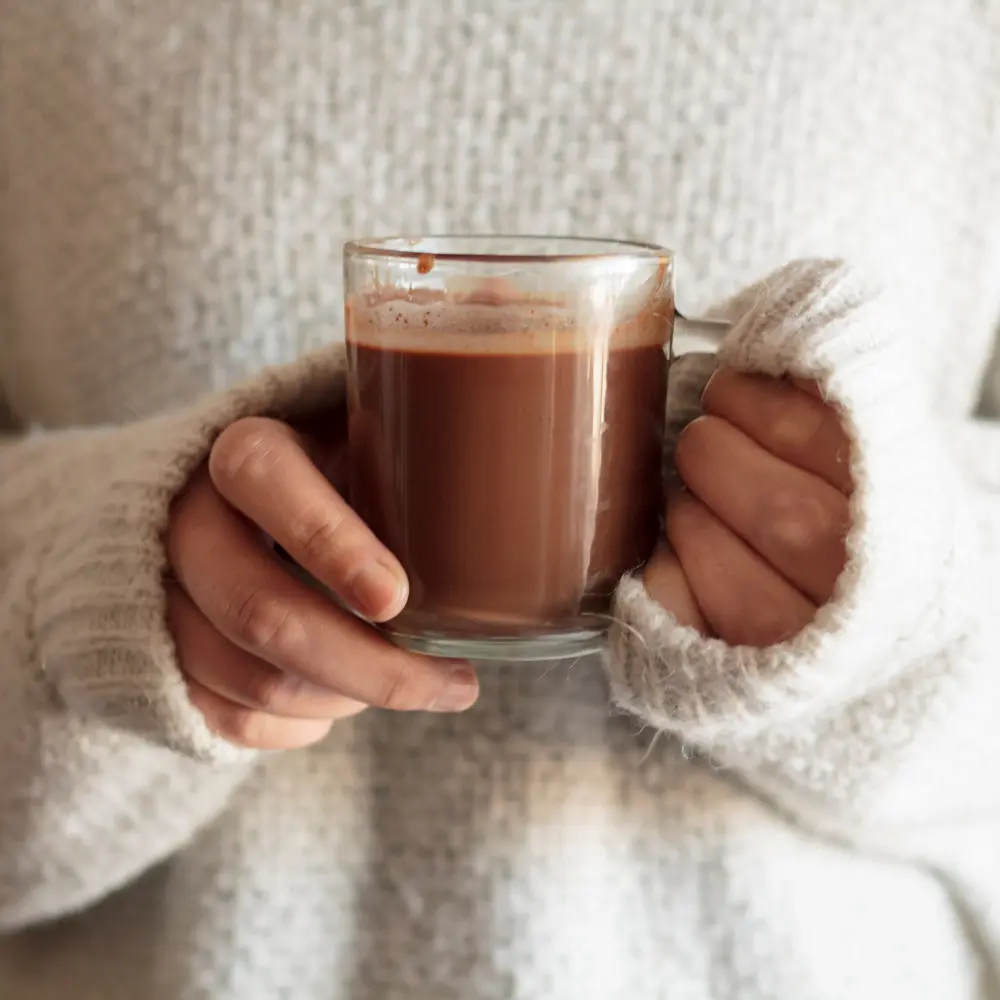
While often considered an indulgent treat, hot chocolate also has health benefits, mainly derived from cocoa.
- Cocoa, the main ingredient in hot chocolate, is packed with antioxidants known as flavonoids. These compounds have been linked to heart health, including reduced blood pressure and improved cholesterol levels. (3)
- Cocoa also contains a compound called theobromine, which can improve mood and brain function.
- Hot chocolate made with milk also provides beneficial nutrients like calcium and vitamin D.
However, like coffee, hot chocolate also has potential drawbacks.
- Traditional hot chocolate can be high in sugar, contributing to weight gain and increased risk of tooth decay when consumed in excess.
- Some people may have difficulty digesting the lactose in milk-based hot chocolates.
The Potential Risks: Coffee vs. Hot Chocolate
When comparing the potential health risks of coffee and hot chocolate, it largely depends on individual factors like genetics, overall diet, and lifestyle.
- Those who are sensitive to caffeine may experience negative effects from coffee, such as jitters, increased heart rate, or disrupted sleep.
- For those watching their sugar intake, traditional hot chocolate might not be the best choice due to its high sugar content. However, this can be mitigated by choosing dark chocolate versions and limiting added sugars.
- It’s always crucial to consider serving sizes. A small cup of coffee or hot chocolate can be part of a healthy diet, but larger serving sizes can lead to excessive calorie, caffeine, or sugar intake.
To sum up, both coffee and hot chocolate have unique health benefits and potential drawbacks. As with all things, moderation and balance are key. It’s also essential to listen to your body and choose the options that make you feel your best.
Caffeine and Beyond: Examining the Science
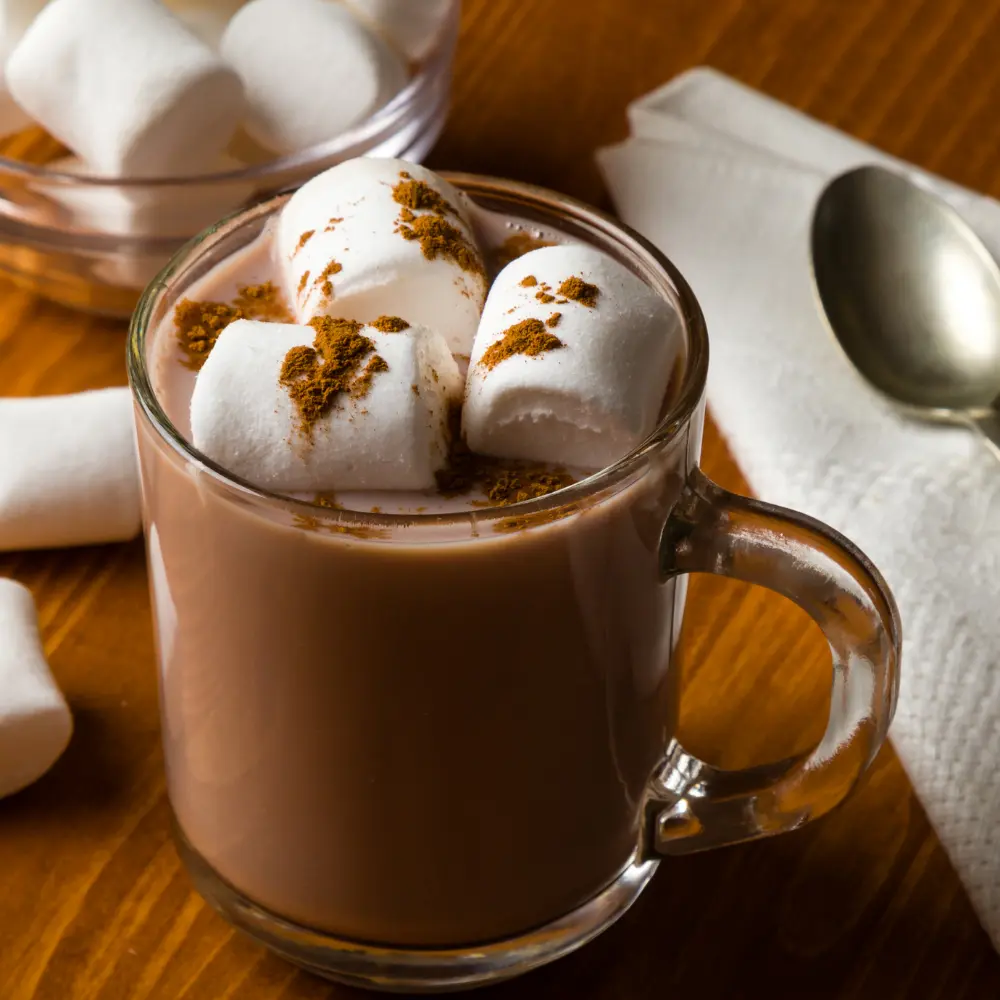
In the debate between hot chocolate and coffee, one factor often considered is their caffeine content. However, there’s more to these drinks than just their caffeine levels. Let’s delve into the science behind these beverages, examining how they interact with our bodies and influence our moods and energy levels.
Hot Chocolate: The Soothing Serotonin Booster
Hot chocolate is traditionally seen as a comforting, soothing drink, and there’s a scientific basis for this.
- First, hot chocolate has significantly less caffeine than coffee, making it a more relaxing beverage. The minimal caffeine in hot chocolate versus coffee can still provide a gentle lift without the stronger stimulating effects of coffee.
- Hot chocolate contains a compound called tryptophan, which is used by the body to produce serotonin, a neurotransmitter known for its mood-boosting effects. Increased serotonin levels can lead to feelings of happiness and relaxation.
- Additionally, the process of drinking a warm beverage like hot chocolate can have a calming effect, further enhancing feelings of comfort and relaxation.
Coffee: Unraveling the Complex Relationship with Dopamine
On the other hand, coffee has a more complex interaction with our bodies, primarily due to its higher caffeine content.
- Caffeine works by blocking adenosine receptors in the brain. Adenosine is a neurotransmitter that promotes sleep and relaxation, so when its receptors are blocked, we feel more alert and awake.
- At the same time, blocking adenosine receptors also allows other neurotransmitters like dopamine to be more active. Dopamine is known as the ‘feel-good’ neurotransmitter, contributing to the mood-boosting effects of coffee.
- It’s worth noting that while coffee can provide a short-term energy boost and mood lift, it can also lead to a ‘crash’ when the effects of caffeine wear off. This is why some people may feel tired or irritable after the caffeine effects diminish.
Decaffeinated Options: Enjoying the Best of Both Worlds
For those who are sensitive to caffeine or prefer to avoid it, there are decaffeinated options for both hot chocolate and coffee.
- Decaf coffee goes through a process to remove most of the caffeine while maintaining its flavor. This allows coffee lovers to enjoy the taste of coffee without the stimulating effects of caffeine.
- While hot chocolate naturally has less caffeine than coffee, some brands offer caffeine-free hot chocolate, often made from carob instead of cocoa.
- Decaffeinated options can provide a great way to enjoy these beloved drinks without caffeine. They allow for the appreciation of their distinct flavors and can be enjoyed at any time of the day without worrying about disrupting sleep.
Whether you’re drawn to the mood-boosting properties of hot chocolate, enjoy the stimulating effects of coffee, or prefer decaffeinated versions, understanding the science behind these beverages can deepen your appreciation for them and guide your choices.
Crafting the Perfect Cup
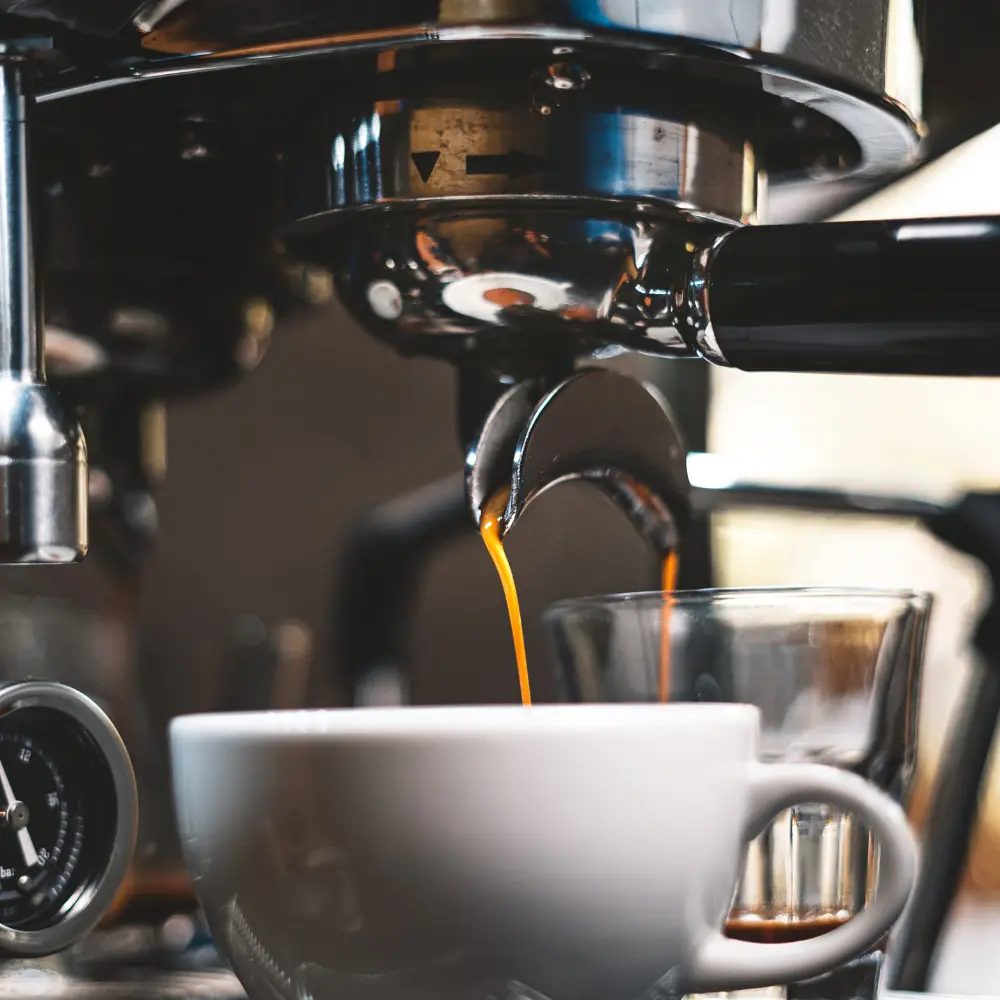
Whether you’re a coffee lover or a hot chocolate enthusiast, part of the joy in enjoying these beverages lies in the crafting process. Each drink has its own unique preparation methods, ingredients, and variations that can affect the taste, aroma, and overall experience.
Hot Chocolate: Exploring Ingredients and Variations
Hot chocolate, at its most basic, is a blend of chocolate or cocoa powder, sugar, and milk. However, there are many ways to craft and customize this classic beverage to suit your tastes.
- The type of chocolate used can dramatically alter the flavor. Dark chocolate will result in richer, less sweet hot chocolate, while milk chocolate will create a sweeter, creamier drink.
- The ratio of chocolate to milk can also be adjusted depending on how intense or mild you want your hot chocolate to be.
- There are numerous variations of hot chocolate worldwide. For instance, Mexican hot chocolate often includes spices like cinnamon and nutmeg for a warmer, spicier flavor. Meanwhile, Italian hot chocolate is typically thick and pudding-like, with a strong emphasis on the chocolate flavor.
- If you’re wondering, “Can you make hot chocolate in a coffee maker?“, the answer is yes! Just replace the coffee grounds with cocoa, add milk to the carafe instead of water, and sweeten to taste.
Coffee: From Bean to Brew – Unveiling the Processes
Coffee, on the other hand, involves a more complex process that begins with the beans themselves.
- The type of coffee bean (Arabica, Robusta, etc.) and its origin can significantly impact the flavor profile, with factors like soil, altitude, and climate playing a role.
- The roasting process also affects the taste of the coffee. Light roasts tend to be more acidic and retain more of the original bean’s flavor, while dark roasts are less acidic and have a stronger, bolder flavor.
- The brewing method is another crucial factor. From espresso machines to French presses to cold brew techniques, each method extracts different flavors and yields a different taste and texture.
- Finally, how you choose to serve your coffee – black, with milk, with sugar, or with flavors – can further personalize your coffee experience.
A World of Possibilities: Personalizing Your Beverage
With such a wide range of options for both hot chocolate and coffee, there’s endless room for personalization.
- For hot chocolate, you might experiment with different types of chocolate, try adding spices or flavorings, or experiment with dairy-free milks for a vegan version.
- For coffee, you could try beans from different origins, experiment with different roast levels, or explore various brewing methods.
- Another way to personalize your beverage is through toppings and add-ons. Think whipped cream, marshmallows, a dusting of cocoa or cinnamon, or even a shot of espresso in your hot chocolate for a “mocha” twist.
To sum up, whether you’re crafting a comforting cup of hot chocolate or brewing a bold cup of coffee, there’s an art to making the perfect cup. By understanding and experimenting with different ingredients, processes, and variations, you can truly make these beverages your own.
Hot Chocolate vs Coffee: The Historical Journey
Unraveling the historical narratives of hot chocolate and coffee allows us to appreciate the deep cultural roots and impact these beverages have had over centuries. The stories behind their discovery, the path of their global spread, and their cultural significance are truly fascinating.
The Origins of Coffee: A Walk Through History

The history of coffee traces back to the misty highlands of ancient Ethiopia, where legend tells us it was discovered not by humans, but by a curious goat herder named Kaldi.
In the unfolding narrative, Kaldi made an intriguing discovery: his goats exhibited remarkable liveliness upon devouring berries from a specific tree. Captivated by this, he proceeded to share his keen observations with the abbot of a nearby monastery. (4) The abbot made a drink with the berries, finding it kept him alert during long hours of evening prayer. The news of this energizing berry spread, eventually reaching the Arabian Peninsula and from there, the world.
- The 15th century saw extensive coffee cultivation in Yemen.
- By the 16th century, coffee houses, known as “qahveh khaneh,” had started to appear in cities across the Near East, from Persia to Turkey. These places were not just about coffee; they were vital social hubs for exchanging information, conducting business, and enjoying music.
- The 17th century marked the advent of coffee in Europe. Despite initial resistance and fear of the ‘bitter invention of Satan,’ coffee houses became popular, serving as centers of social activity and communication.
- At last, during the late 17th century, Coffee houses emerged in Western Europe, particularly in Holland, England, and Germany. One of the initial instances of coffee cultivation in the New World occurred when Gabriel de Clieu transported coffee seedlings to Martinique in 1720. These seeds eventually gave rise to 18,680 coffee trees, facilitating the expansion of coffee to other Caribbean islands like Saint-Domingue and even reaching Mexico. By 1788, Saint-Domingue was responsible for providing half of the world’s coffee.
Hot Chocolate’s Historical Timeline: From Aztecs to Today
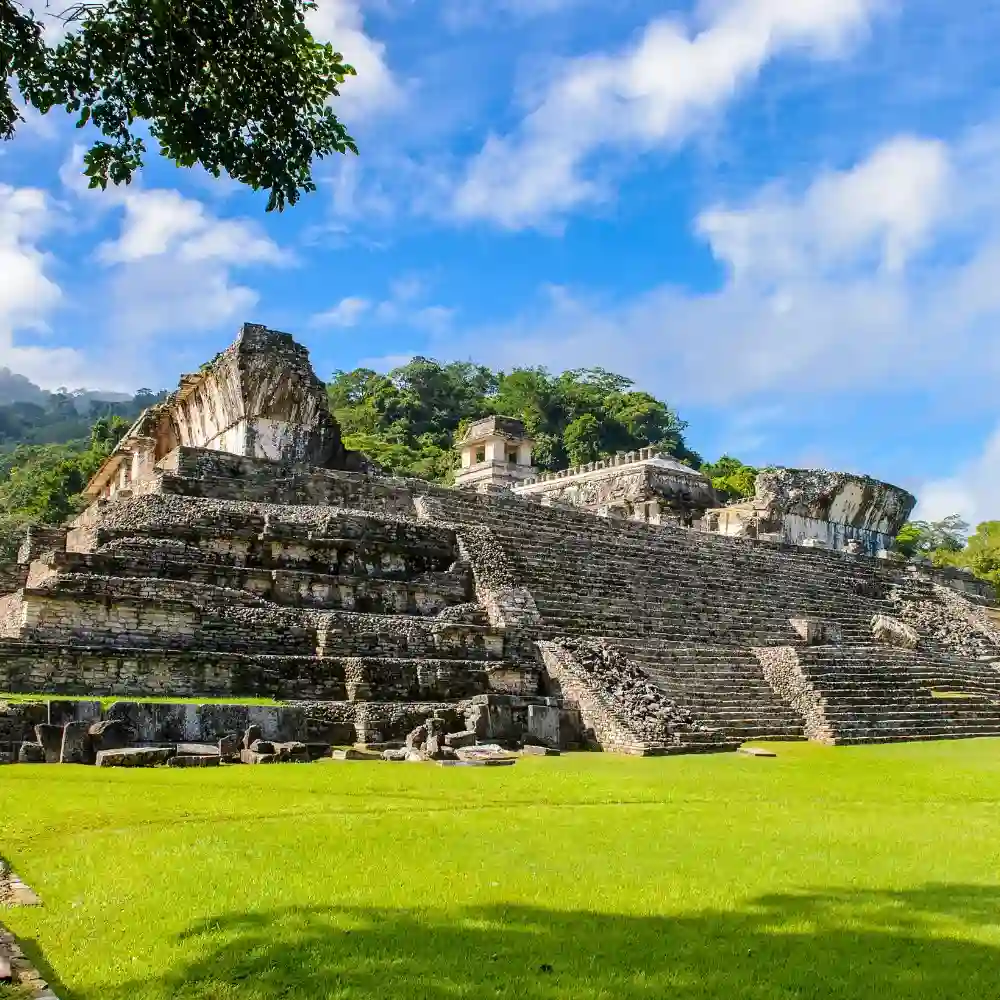
The journey of hot chocolate is equally as enchanting, tracing back to the ancient civilizations of Mesoamerica. The cacao tree, Theobroma cacao, or “food of the gods,” was highly valued in the Aztec and Maya civilizations.
- The Mayans were the first to cultivate the cacao tree, using the beans as a ritual beverage and a currency. Their drink, a mix of ground cacao beans, water, cornmeal, and chili peppers, was quite different from the sweet hot chocolate we know today.
- When the Spanish conquistadors arrived in the 16th century, they took cacao back to Europe, where it became a luxury item among the aristocracy.
- It wasn’t until the 17th century, with the invention of the steam engine, that chocolate became a more accessible commodity. This led to the creation of the first chocolate bars and, eventually, the hot chocolate drink we are familiar with.
Coffee and Hot Chocolate: Cultural Influence Through the Ages
The cultural influence of coffee and hot chocolate is far-reaching. They’ve played vital roles in social rituals, economic development, and artistic expression worldwide.
In Ethiopia, the birthplace of coffee, the traditional Ethiopian coffee ceremony still holds significant cultural importance. It’s a ritualized form of hospitality, a time for socialization, and a spiritual experience.
- The ceremony involves roasting the coffee beans in a pan, grinding them in a mortar, and brewing them in a special clay jug known as a “jebena.” The coffee is then served in small cups, accompanied by traditional snacks.
- This ceremony, rich in symbolism and tradition, is a fundamental part of Ethiopian social and cultural life.
As for hot chocolate, its cultural significance can be traced back to the Aztecs. It was a sacred beverage, consumed during religious ceremonies and used as a form of currency.
- In the modern world, hot chocolate has become a symbol of comfort and indulgence, often associated with winter holidays and cozy moments.
- Specialized hot chocolate shops have popped up worldwide, showcasing the versatility and global love for this sweet, warm beverage.
It’s clear that both coffee and hot chocolate have traveled a long way from their origins, evolving over the centuries to become much more than just beverages. They are embedded in our cultures, traditions, and everyday lives in ways that extend far beyond their taste and nutritional benefits.
The Role in Modern Lifestyle and Culture

In the Hot Chocolate vs. Coffee debate, there’s more at stake than just taste or health benefits. These drinks have deeply ingrained roles in modern lifestyle and culture, becoming symbols of comfort, community, and creativity.
Coffee Culture: More than Just a Morning Boost
Coffee is more than just a morning pick-me-up—it’s a culture in its own right.
- From the traditional Ethiopian coffee ceremony to the Italian espresso bars and the modern artisanal coffee shops, coffee has a strong communal aspect. These gatherings often facilitate social interaction, providing a setting for conversations, meetings, and even creative brainstorming sessions.
- The act of brewing coffee at home, too, has become a cherished ritual for many, offering a mindful start to the day.
- Furthermore, coffee culture has sparked innovation and creativity, as evidenced by the rise of specialty coffee, latte art, and various brewing techniques.
Hot Chocolate: Comfort in a Cup and Beyond
Hot chocolate, while less ritualized than coffee, holds a special place in our hearts and cultures.
- Often associated with warmth and comfort, hot chocolate is a beloved beverage during the colder months and is a staple during holiday celebrations.
- In some cultures, hot chocolate is an essential part of breakfast, like in Spain, where it’s traditionally served with churros.
- Hot chocolate also symbolizes childhood and nostalgia for many, reminding us of cozy afternoons at home or festive holiday gatherings.
Coffee and Hot Chocolate in Pop Culture: Movies, Books, and More
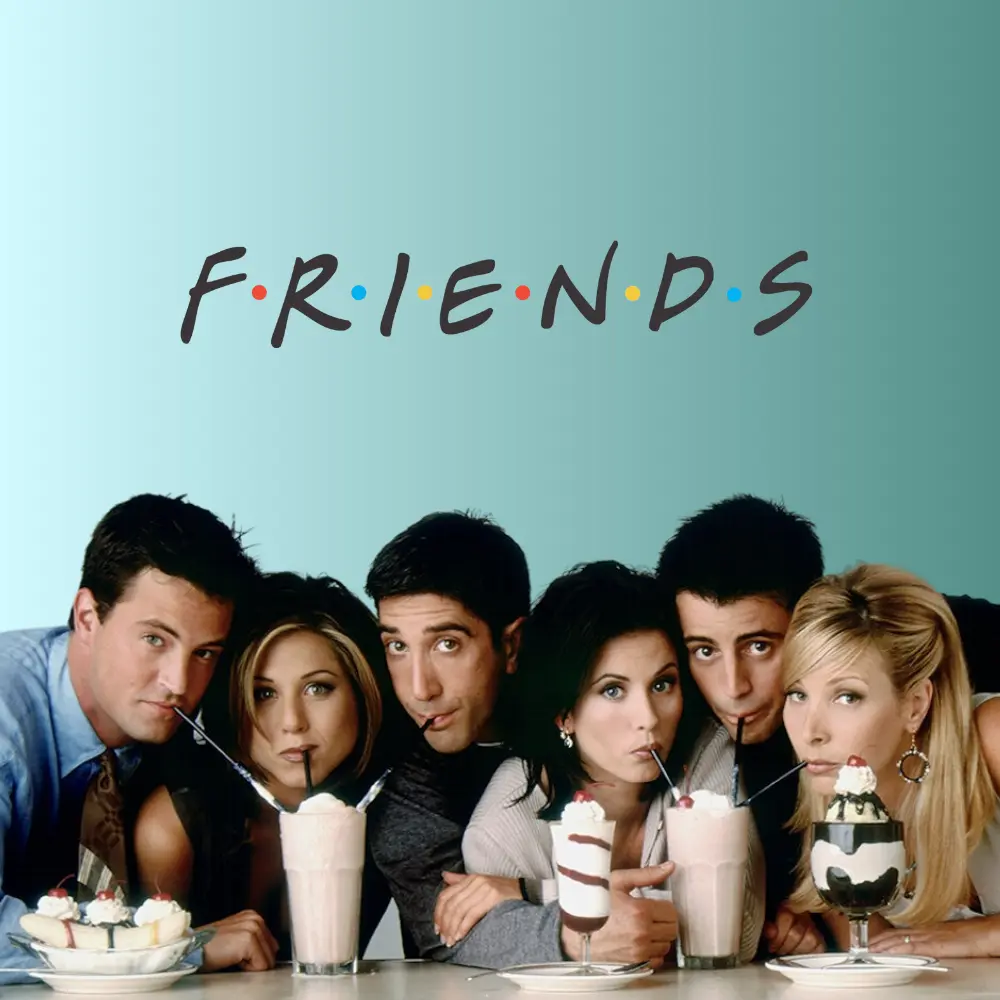
Coffee and hot chocolate have also left their mark on pop culture, often serving as key elements in movies, books, and TV shows.
- Coffee is often portrayed as the fuel of bustling cities and busy professionals. Iconic TV shows like “Friends” and “Gilmore Girls” often feature coffee shops as central settings, further solidifying coffee’s role in our social fabric.
- Hot chocolate, on the other hand, is often associated with comfort and family time. A notable example is the “Polar Express” movie, where hot chocolate symbolizes the magic and wonder of childhood.
- The enduring presence of these beverages in pop culture underscores their significance and emotional resonance.
From their unique flavors and health benefits to their cultural impact and symbolism, both coffee and hot chocolate have distinctive charms. Choosing between them ultimately depends on personal preferences, mood, and occasion. One thing is for sure: both drinks have a special place in our lives, offering comfort, connection, and a bit of daily indulgence.
The Science Behind the Love for Coffee and Hot Chocolate
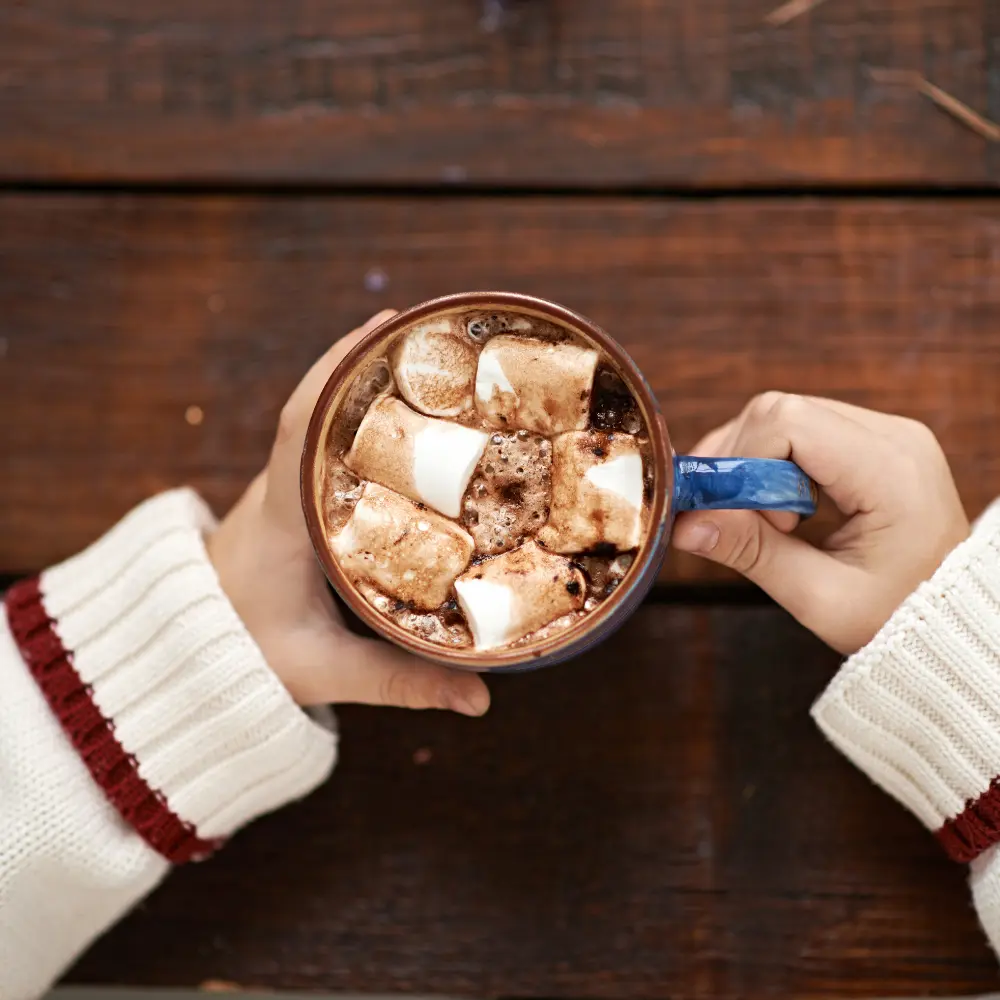
In the ongoing debate of Hot Chocolate vs. Coffee, it’s important to understand the science behind our love for these beverages. Beyond the surface-level enjoyment of their flavors, there are psychological and neurological mechanisms at play that influence our preferences and attachment to these drinks.
The Psychology of Coffee: Why We Love a Cup of Joe
Coffee, with its enticing aroma and energizing effects, has a profound psychological impact that explains its widespread popularity.
- Coffee acts as a stimulant, providing us with an energy boost that many rely on to start their day or fight off afternoon sluggishness. This immediate reward often leads to positive reinforcement, with coffee consumption becoming a habitual part of our daily routines.
- The smell of coffee alone can have a significant psychological effect. Research suggests that the aroma of coffee can help reduce stress and increase feelings of anticipation and excitement.
- Social psychology also plays a role. Coffee shops and cafes have become popular social settings, and sharing a cup of coffee with others can foster feelings of belonging and community.
The Neurological Response to Hot Chocolate: A Sweet Love Affair
Hot chocolate, with its rich, sweet flavor and comforting warmth, triggers an array of positive neurological responses.
- One key factor is that hot chocolate is often associated with positive memories—such as holiday gatherings or cozy winter evenings—which can stimulate the release of endorphins, our body’s natural “feel-good” hormones.
- As mentioned earlier, hot chocolate also contains tryptophan, which the body converts into serotonin. This neurotransmitter helps regulate mood, with increased levels leading to feelings of well-being and happiness.
- The sweet taste of hot chocolate also stimulates the release of dopamine, another “feel-good” neurotransmitter that’s associated with pleasure and reward.
The Role of Coffee and Hot Chocolate in Cognitive Functioning
Both Hot Chocolate and Coffee can also have effects on cognitive functioning, although they do so in different ways.
- As previously discussed, coffee, with its caffeine content, is well-known for its ability to enhance alertness and improve concentration. It can provide a much-needed energy boost, improving productivity and cognitive performance.
- Hot chocolate, while less potent, can still contribute to cognitive functioning. Research suggests that the flavonoids in cocoa can help improve blood flow to the brain, potentially enhancing cognitive function and mood.
- However, it’s important to note that these effects can vary depending on individual differences and the amount consumed. It’s always best to enjoy these beverages in moderation.
Understanding the science behind our love for coffee and hot chocolate provides a fascinating glimpse into the powerful interplay between our brains and the foods and drinks we consume. It adds another layer of appreciation for these beloved beverages, beyond their taste and cultural significance.
Conclusion
As we’ve journeyed through the world of Hot Chocolate vs. Coffee, we’ve discovered the distinct charms and depths of these two beloved warm drinks. From their intriguing historical journeys to their unique flavor profiles, from their cultural roles to their health implications, each has its own magic to offer.
Both coffee and hot chocolate have carved out unique places in our routines, rituals, and hearts. Coffee, with its rich flavors and invigorating effects, offers us a sense of community, routine, and a much-needed energy boost. On the other hand, hot chocolate, with its comforting sweetness and soothing warmth, provides a sense of nostalgia, comfort, and tranquility.
Moreover, the science behind our love for these drinks, their impact on our mood, cognition, and well-being, further deepens our understanding and appreciation. Whether you’re a coffee enthusiast seeking the perfect brew or a hot chocolate lover exploring variations, there’s always more to learn and enjoy in this delicious dichotomy.
So, the next time you find yourself in the Hot Chocolate vs. Coffee debate, remember that it’s not just about picking a side. It’s about understanding and appreciating the unique charm each drink brings, and above all, savoring the joy they bring to our everyday lives.
FAQ
How have coffee and hot chocolate shaped history?
Coffee and hot chocolate have deeply influenced history, with coffee shaping global trade routes and societal structures, and hot chocolate playing a significant role in ancient cultures like the Aztecs and Mayans.
What are the different flavors of coffee and hot chocolate around the world?
Coffee flavors vary based on origin, roast, and brew method, from fruity African blends to nutty South American ones. Hot chocolate ranges from the creamy Belgian style to the spicy Mexican version.
How do coffee and hot chocolate impact our brains?
Coffee, due to its caffeine content, can enhance alertness and focus, while hot chocolate can boost serotonin levels, contributing to a sense of well-being and happiness.
What is the role of coffee and hot chocolate in today's culture?
Coffee is often associated with productivity, community, and artisanal culture, while hot chocolate symbolizes comfort, warmth, and nostalgic joy.



